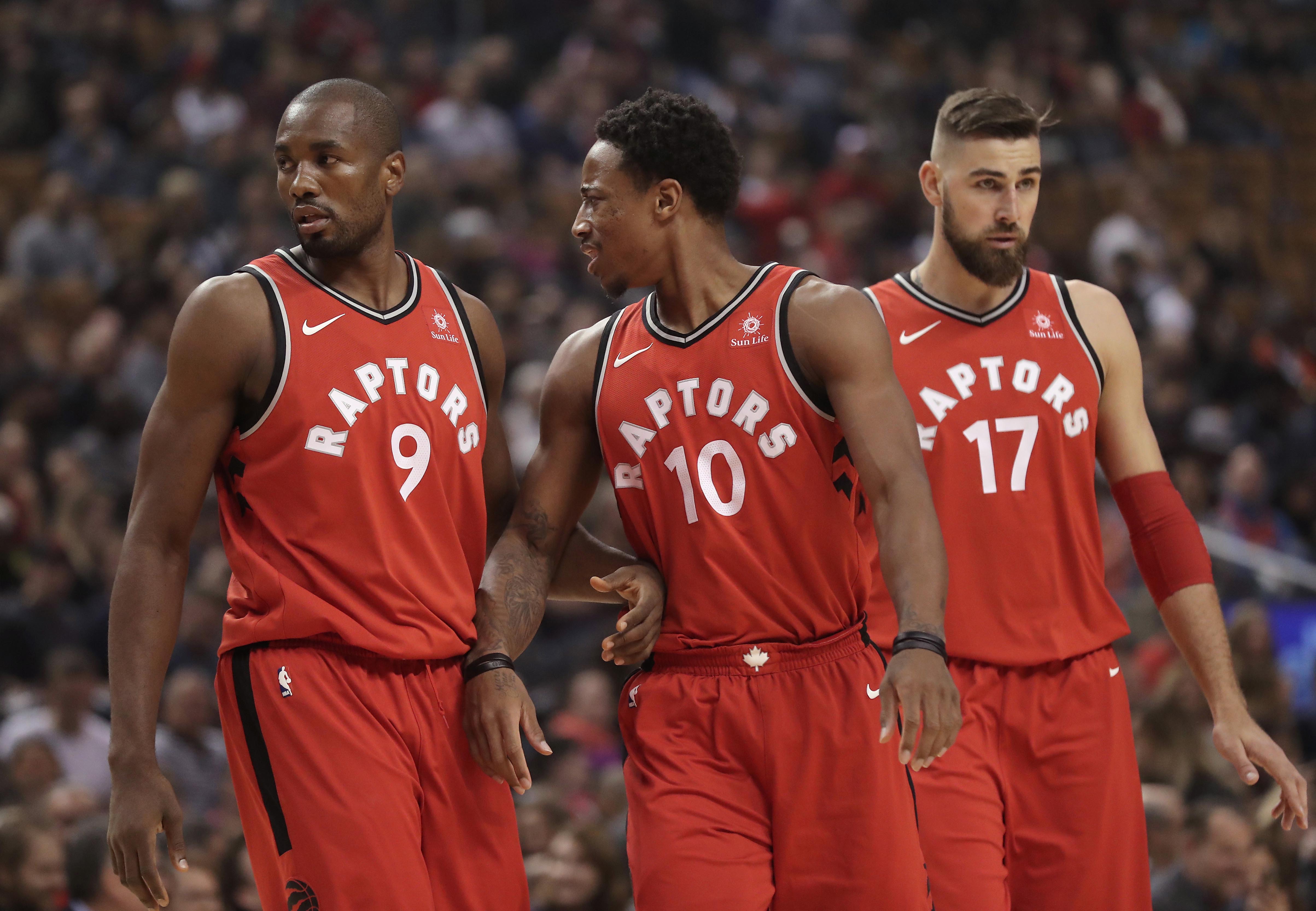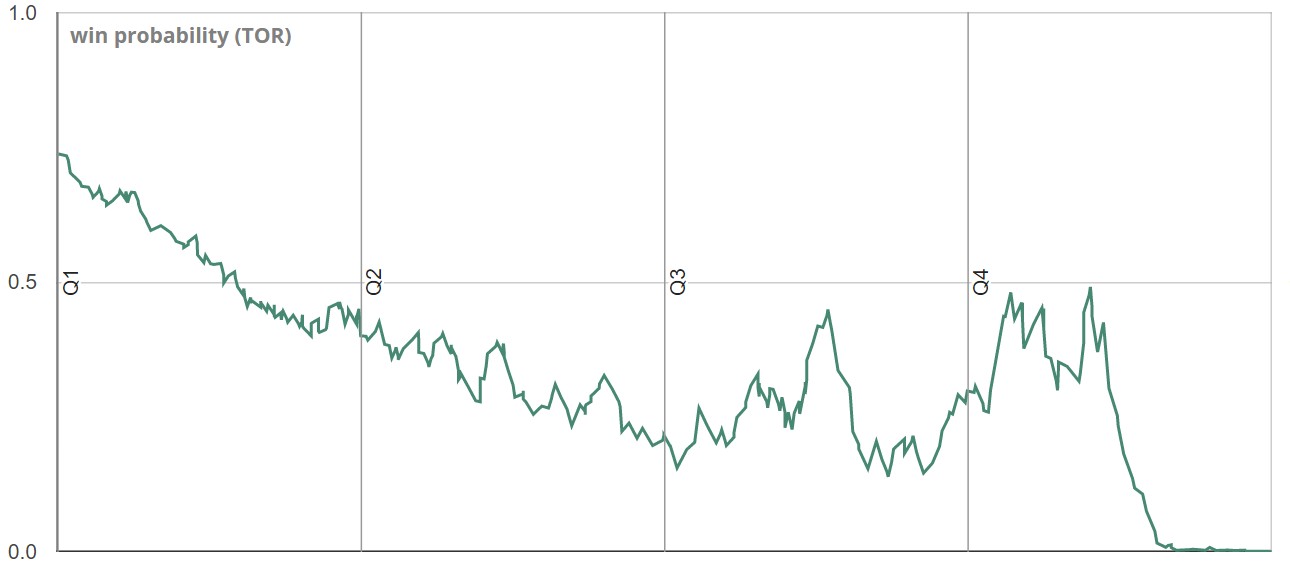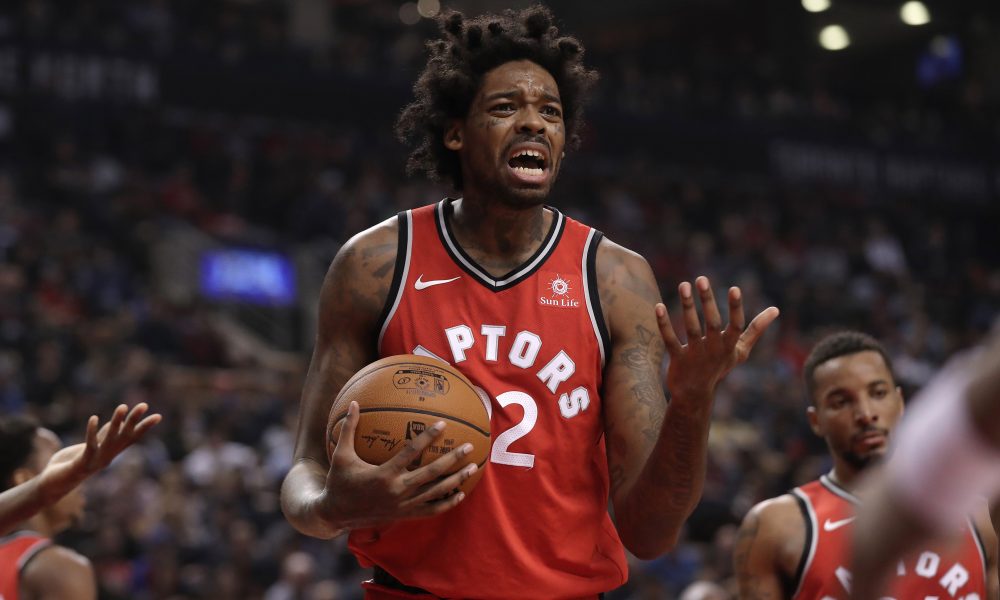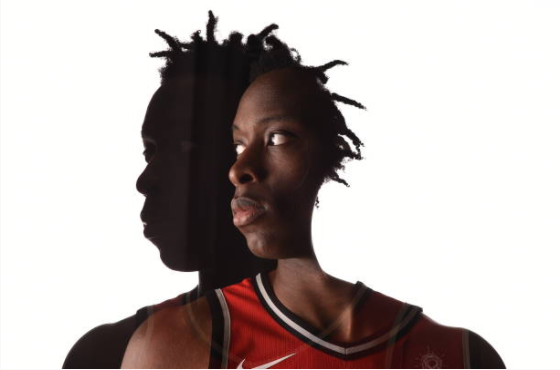The Toronto Raptors lost Sunday’s game against the Washington Wizards in the opening six minutes, really. There was a lot of post-game talk about finding ways to get off to better starts after the team came out cold for a second time in three games, and with at least one fixture of the starting unit, it was clear that some early frustration may be setting in. Two of the starters have missed time to injury, one got himself ejected in a game, and in general, the quintet hasn’t spent a whole lot of time together.
It’s early still, in other words, and while patience is perhaps at a premium already – in large part because bad starting units have been a fixture of the Raptors’ success in the last half-decade – there probably needs to be more of a sample and more opportunity for the group to mesh before panic sets in. A minus-12 in six minutes that turned a nearly three-quarters win probability to a coin flip at home against a team missing their superstar, though, is a missed opportunity and at least a little concerning inside the locker room.
“It should be,” Fred VanVleet said. “We’re not overreacting, obviously, it’s still early. But I think we need to get a little kick in the butt here and get it going to start the games, and the second unit has to be ready coming off the bench to spark it if we’re not there. Obviously, it’s hard to win in this league when you’re starting like that, or there’s games when the second unit isn’t coming in with the proper energy as well. That’s what I focus on. I’m not concerned with the starters. We can count on those guys. We just, obviously we need everybody to perform at a high level.”
The Raptors came back, though, nearly erasing a lead that at one point reached 19. With Kyle Lowry banished, the second unit came in and brought a bit of a spark, and a 7-1 run late in the second quarter helped prevent things from getting beyond striking distance. The starters with Delon Wright played better in the third quarter, including a 10-1 run, and then, as has so often been the case early on this year, the bench made a big push. The Raptors had the lead down to single digits entering the fourth on the back of some terrific defensive energy and a punishing transition game.
An all-bench unit anchored by VanVleet would continue that success into the fourth, suffocating the Wizards at one end, enough that some stalled possessions on offense didn’t derail a methodical comeback. The lead shrunk to four, DeMar DeRozan returned to give the group some needed offensive punch, and the Raptors pulled within a possession with 7:24 to play.
It was at that point that head coach Dwane Casey began filtering other starters back in, a point of consternation for many after the game. The Wizards began pulling away, the rest of the starters came back in, and the game fell through their fingertips thanks to a 13-1 run.
“We dig ourselves in a hole like that at the beginning of the game, we end up scratching and clawing and using our energy to get back in the game,” Norman Powell said. “We made it close in the second half, but we just exerted our energy so much just trying to get back in the game.”
At the time the starters came back in, I tweeted the following:
Really, who cares if you ride the young guys and it comes up short? Starters have been bad, bench made this a game.
— Blake Murphy (@BlakeMurphyODC) November 6, 2017
This was perhaps not entirely fair. Watching it back this morning, I feel less strongly than I did as things were unfolding. There were reasons Casey went back to his starters when he did, and they were largely reasonable:
- They needed DeRozan to score. Outside of some tough VanVleet finishes at the rim, the second unit can’t create a ton of offense on its own unless they’re scoring off of stops. As the Wizards brought their own more talented players back into the game, Casey was likely worried about the group being able to complete the comeback simply from VanVleet hurling himself at the rim.
- OG Anunoby had a tough stretch where he missed consecutive attempts to take Otto Porter off the bounce and botched a pick-and-roll coverage at the other end. He’d played nearly nine minutes straight, which is on the high end for what he’s done since his return, and it’s possible he was hitting a wall.
- Casey was worried about that groups’ fatigue in general. Questioned about the choice after the game, Casey said the bench players were winded, and that makes sense given most of them had been playing since the middle of the third quarter. It’s easy to neglect this factor when questioning rotation choices, but playing someone who usually only averages 16 minutes for 16 minutes straight is a big ask. Lucas Nogueira, in particular, was coming off of a high-energy stretch and probably needed a breather. I’m not sure Pascal Siakam gets fatigued.
- The starters still need to be given chances to play, find a rhythm, and hopefully improve as a group, and it’s difficult to sit a team’s best players with the game in the balance.
It’s the last point that I disagree with most and was the cause for my tweet in the fourth. As part of the culture reset, the Raptors probably want to enforce accountability of play, and Casey’s improved over the years in terms of riding with players who are outperforming their starting counterparts, even in high-leverage spots like that playoffs. You don’t have to give the closing opportunities to these players, but “play your best players late” is almost always going to be a logical counter to riding the hot hand. In this case, the starters had largely shaken off their tough start, too, and looked better with Delon Wright or VanVleet with them after Lowry’s ejection (this is not a Lowry thing, it’s likely a regression/waking up thing).
Still, my point was not that the bench group would necessarily give the Raptors the best chance to win. When you get down 19, squander your home-court advantage, and at one point hit a 13.8-percent win probability in the third quarter, you’ve essentially lost the game. The Raptors are two-time defending 10-plus-point-comeback champions, and stealing this kind of game has become a part of their identity, sure. There are occasions on which I feel like it makes sense to reward those who turned it back into a game (a 35.3-percent win probability swing in eight minutes), and I felt like this was one of those times.
Admittedly, that’s an easy opinion to hold in hindsight (though I held it in the moment, too) and ignores a lot of the factors a head coach has to deal with when making those decisions on the fly. It’s also largely subjective, which is not how the best decisions are made. It is, to be completely fair, a little hypocritical of me to trumpet “Casey should have done X” when the bulk of the analysis I provide would often suggest “he should do Y.” These inconsistencies offer some cognitive dissonance.
Still, returning to all of the starters probably wasn’t the right call, especially the Serge Ibaka-Jonas Valanciunas pairing. Ibaka had a fine offensive game (but continues to struggle defensively) and Valanciunas was bringing a nice energy at that end (he had a better second half than first and was not at the top of the list of reasons Bradley Beal went off), but there’s evidence it’s not an ideal duo, and Valanciunas seemed a little uncomfortable defending through a tight whistle for a second game in a row. Valanciunas fouled out and forced Casey’s hand in sliding Ibaka to center late, but that move (or bringing Nogueira back in, or using Siakam) probably came a few minutes late. Alternatively, maybe the bench had another two minutes in them before this move was necessary.
An aside: It’s ironic that Valanciunas is now a member of the “Casey only wants to close with his veterans” side of things rather than the “Casey won’t play youth/Casey won’t play Valanciunas in the fourth” side, even if neither is true. Strictly for curiosity, here’s a look at the Raptors’ playing time by minute, courtesy NBARotations. It’s very noisy because so many pieces have been in and out of the lineup already.
All of this is to say, there are a lot of factors to balance when closing out a game. It’s really easy when something doesn’t work to suggest something different should have been done. In this case, a lot of people probably didn’t like the moves as they were happening, and even then there were reasonable justifications for most of them, and there’s a good chance the alternative would have come up short, too. This is why it’s probably best not to get down 19 in the first place, or to start games in double-digit holes.
“We have to decide who we want to be. Do we want to be an inconsistent team, or a consistent, fighting team like we played in Portland and Utah, or do we want to be like we were in Denver or tonight?” Casey said. “We can be a good team if we’re consistent, have consistent performances or we can be average like we are now. We have to decide what we want to do.”
The starting unit has some things to figure out, as they’ve been outscored by 7.6 points per-100 possessions. An all-bench group is not going to provide a panacea, especially against opponents with strong benches or who stagger multiple stars well. There are some hybrid units that have been quite good, and as Casey trims the rotation back down to 10 (at some point, theoretically), the rotation patterns should settle in and the sample for each group will expand. It’s tough to have two signature frustration losses in the first nine games of the year, but it is early still, and there was always going to be a bit of a learning curve to this season.
Letting the primary guys try to close one out and play through their early struggle, even if a meritocracy may have suggested only one or two of them belonged out there, is sometimes a part of that. Even if it’s open to second-guessing.





